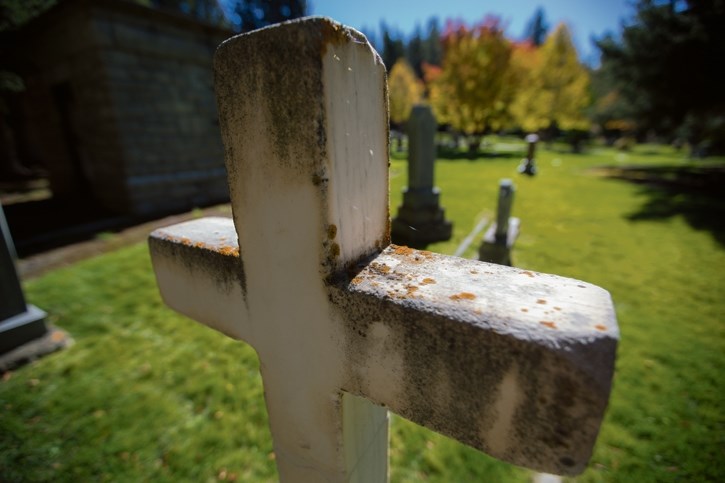The Old Banff Cemetery is steeped in history as the final resting place for many of Banff’s earliest pioneers.
Not only that, the cemetery has a design unique to Canada and also includes intentional landscaping and a park-like setting that reflects common practice in late 19th-century burial grounds.
Heritage preservationists say for these reasons, the A-ranked property is worthy of designation as a municipal heritage resource, noting it would be only the second cemetery in Alberta to be designated.
“This is a really interesting designation opportunity because it gives us the chance to expand our heritage portfolio beyond just built heritage, which is where we’ve largely focused in the past, and look at cultural landscapes and sites that also tell important stories of the history here in Banff,” said Emma Abramowicz, heritage planning intern with the Town of Banff.
“This cemetery is significant for its unique design and its park-like landscaping, but this cemetery carries even more weight as a place where Banff’s founding families are buried. It has incredible potential to teach us about early life in Banff, not only about our cultural burial practices, but about the lives of early residents.”
On Monday (Sept. 26), council authorized administration to advertise its intention to designate the Old Banff Cemetery at the east end of Buffalo Street as a municipal historic resource. They’ll bring a designation bylaw back for council’s consideration within 120 days.
The intent of a municipal historic resource designation is to recognize the significance of a property and ensure continued protection and maintenance of vital heritage aspects of a property.
“Unlike many other heritage designations, this one wouldn’t really be intended to protect the cemetery from redevelopment, or from the irreversible alteration of heritage character, because that’s unlikely to happen here,” Abramowicz said.
“We would designate instead because we want to recognize it’s an important historic site within our town, and in this the Town can model good stewardship over heritage resources and specifically cultural landscapes.”
The cemetery, nestled between Buffalo Street, Wolverine Street and the base of Tunnel Mountain, was established in the 1800s and was formally designated a burial ground in 1890.
There were two extensions to the cemetery over the years, one in 1933 and another in 1939 before it was deemed full in the 1940s. Burials in recent years are limited to those whose families are already there.
Residents of Banff and Bankhead were buried at the Old Banff Cemetery, including notable residents such as Dr. Robert Brett, Jim Brewster, Mary Schaffer Warren, Norman Luxton, Norman Sanson and Bill Peyto.
Abramowicz said the cemetery needs to be recognized for its association with Banff’s founding families, noting while most designated cemeteries recognize some burials of notable citizens, this cemetery is the final resting place of the vast majority of Banff’s notable pioneers.
“The cemetery’s significance is not only for its association to notable residents and cultural burial practices, but also for its actual information potential, which becomes increasingly important as long-term residents continue age,” she said.
“It allows us to trace birth and death dates, occupations and interests, and even blood and marriage relationships between Banff’s founding families.”
The cemetery has several unique features that make it significant from a heritage perspective.
Its original oval-shaped layout with cross-shaped pathways, which was not replicated in later extensions, is unique to Canada. It also has a secluded and park-like setting, including tall aspen and spruce trees that line the original pathways.
“This was the sort of approach that was taken with cemeteries at the turn of the century. They were non-denominational and they were supposed to feel rural and park-like and natural, so this cemetery is representative of that trend,” said Abramowicz.
“The oval and cross design is clearly intentional, but it’s not modeled after any cemetery that we found anywhere. But it’s aesthetically pleasing and easily recognizable from aerial imagery.”
The cemetery has several other significant historically significant features, too.
There is a military field of honour in the 1933 extension, representing military burial practices across Canada.
A trend in Banff is the frequent inclusion of mountain and nature focused carvings and castings on tombstones.
“The use of local materials in the retaining walls and construction of the three mausolea and the 1933 toolshed contributes additional character unique to Banff,” Abramowicz said.
Recognition of burial grounds as heritage resources is common across Canada, with a total of 522 cemetery designations in Canada at either the municipal, provincial or national level.
Only one other cemetery in Alberta is designated – the Hillcrest Cemetery in Crowsnest Pass.
Abramowicz said its heritage value comes specifically from its association with the worst mining disaster in Canadian history, the Hillcrest mining explosion in June, 1914, noting 180 miners who died in the explosion are buried at this cemetery.
“This designation represents one of the less common types, where the cemetery is recognized for its association for a special historic event,” she said.
Chip Olver, who is council’s representative with Banff’s heritage corporation, said the group’s members are very excited about the proposed designation.
“Usually designation involves buildings and what’s interesting about this is it’s actually a cultural landmark and has an incredibly rich history of early pioneers and a memorial section for World War One veterans,” she said.
“You just have to walk through it to realize how worthy it is of designation.”
Designation means the cemetery would be eligible for grants from the provincial government of up to $50,000 annually, which is in contrast to its current provincial eligibility for a one-time grant of up to $5,000.
Under Banff’s own heritage resource policy, Old Banff Cemetery would be entitled to a maximum grant of $50,000 under Banff’s heritage resource policy; however, administration is recommending $10,000-$15,000 be allocated incrementally over the next 10 years.




